.gif)
Altstadt (Zürich)
Encyclopedia
Altstadt in the Swiss
city of Zürich
encompasses the area of the entire historical city before 1893, before the incorporation of what are now districts 2 to 12 into the municipality, over the period 1893 to 1934. Altstadt approximately corresponds to the area enclosed by the former city ramparts
, and is today within the administrative area of the city called Kreis 1 (District 1).
With a population of just below 5,600 (as of 2005), it houses about 1.5% of the city's total population.
Administratively, District 1 is divided into four parts or quarters by the Zürich
statistical office, Rathaus, Hochschulen, Lindenhof and City. Lindenhof and Rathaus correspond to the parts of the medieval city left (west) and right (east) of the Limmat
, respectively, while City and Hochschulen include the area of the Early Modern city west and east of the medieval walls, respectively.
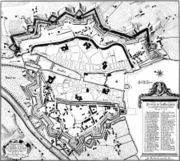
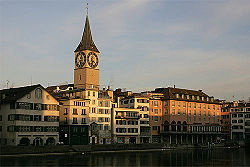 The Lindenhof quarter corresponds to the mindere Stadt, the smaller but more prestigious half of the medieval town left of the river. This is the oldest core of the city, with settlement traces dating to pre-Roman (La Tène
The Lindenhof quarter corresponds to the mindere Stadt, the smaller but more prestigious half of the medieval town left of the river. This is the oldest core of the city, with settlement traces dating to pre-Roman (La Tène
) times, and fortified as a Roman oppidum
with a surrounding vicus
in the final decades of the 1st century BC.
The Lindenhof hill
itself is the site of the Roman castle, rebuilt in Carolingian
times but derelict by the 13th century, when it was used as a quarry for the first stone houses of rich burghers of the recently reichsfrei city. The Schipfe
quarter at the Limmat
river below the Lindenhof is the site of the Roman vicus, with traces of a hypocaustum excavated. St. Peter church was the parish church of the medieval city, built on the site of an earlier temple to Jupiter.
The Rennweg
street below the Lindenhof hill was the main street of the medieval city, entering by the Rennweg gate through the western city wall (now marked by the course of the Bahnhofstrasse. Augustinergasse
is a small street leading from St. Peterhofstatt situated at the St. Peter church, passing the former Augustinians
monastery below the Lindenhof hill, towards the Kecinstürlin gate at the southern Fröschengraben moat, Bahnhofstrasse as of today. The quarter contains the Fraumünster
, the abbey which ruled the town until the 1336 "guild revolution" of Rudolf Brun
and which remained highly influential until Zwingli's Reformation. Zunfthaus zur Meisen
at Münsterhof
plaza near Fraumünster church houses the porcelain and faience collection of the Swiss National Museum
. Lindenhof also contains the former Augustinian
abbey, and formerly the Oetenbach abbey north of the Lindenhof hill, demolished in 1903 to make way for the Uraniastrasse as part the partially built «Urania-axis» Sihlporte–Uraniastrasse–Zähringerplatz by Gustav Gull, and the Urania Sternwarte
.


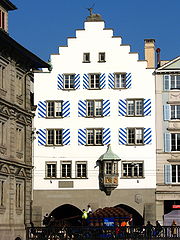
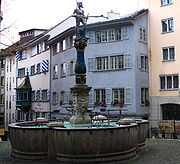 The Rathaus quarter is named for the town hall
The Rathaus quarter is named for the town hall
, built in the 1690s.
It is the part of the medieval town on the right side of the Limmat, separated by the Hirschengraben from the Hochschulen quarter to the east, and delimited by the Bellevue and Central squares to the south and north, respectively. As such, it includes the Limmatquai as well as the Niederdorf
(downstream of the Rathaus) and the Oberdorf (upstream of the Rathaus). The historical name of this eastern half of the medieval town was "greater town" (mehrere Stadt), contrasting with the "lesser town" (mindere Stadt), the western half along the left river bank.
and 1835–1839 the portion from the Wasserkirche to Bellevue, formerly called Sonnenquai. At the Limmatquai are located some guild houses, as Zunfthaus zur Zimmerleuten, Zunfthaus zur Haue
, Zunfthaus zum Rüden
and Zunfthaus zur Saffran.
Trams
4 and 15 run along the Limmatquai, serving the stops Helmhaus, Rathaus and Rudolf-Brun-Brücke. The quai was one of the main routes through the old town before it was freed from traffic in 2004.
The bridges passed by the Limmatquai, south to north, are:
north of Limmatquai:
So defined, the Niederdorf includes Rindermarkt and Neumarkt, Froschaugasse and the area of the medieval Jewish quarter, the Predigerkirche (the former blackfriars' abbey) at Zähringerplatz (historically the city hospital, now housing the city library
) and the Zähringerstrasse.
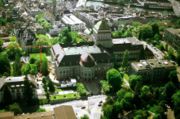

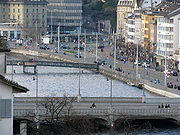 Hochschulen is wedged between Hirschengraben (the historical course of the eastern moat) and Rämistrasse, corresponding to the area taken up by the eastern fortifications of the 17th century ramparts
Hochschulen is wedged between Hirschengraben (the historical course of the eastern moat) and Rämistrasse, corresponding to the area taken up by the eastern fortifications of the 17th century ramparts
(destroyed following the 1839 Züriputsch
), the hillside now holding the main buildings of both ETH Zurich
(built 1861 to 1864 under Gustav Zeuner
) and University of Zurich
(built 1914 under Karl Moser
), at the sites of the Kronen Bollwerk and Schönenberg Bollwerk ramparts, respectively. Hochschulen borders on District 6
(Unterstrass
and Oberstrass
) to the north, on District 7
(Fluntern
and Hottingen
) to the east and on District 8 (Mühlebach
) and Seefeld
) to the south.
Hochschulen in its southern end also includes the Bellevue and Sechseläuten
squares as well as the theater
and opera house
and the Stadelhofen
train station. Tram stops
in the Hochschulen quarter are: Central, ETH/Universitätsspital, Kantonsschule, Kunsthaus, Neumarkt, Bellevue, Opernhaus and Stadelhofen. Line 9 follows Rämistrasse which separates Hochschulen from Fluntern
, line 3 follows Hirschengraben and Seilergraben (the historical eastern moat), which separates it from the Rathaus quarter. The Polybahn
connects Central and the ETH Zurich
main building.
junction, served by lines 3, 4, 6, 7, 10 and 15 besides buses 31 and 46. Formerly called Leonhardsplatz, it was renamed after the Hotel Central built in 1883.
and the Kunsthaus Zürich
.
junction, served by lines 2, 4, 5, 8, 9, 11 and 15 besides buses 912 and 916. It is situated at the lakeside, just north of Sechseläutenplatz. It is named for the Grandhotel Bellevue built in 1856.
, a traditional Zurich festival that is celebrated there.
Stadelhofen station, on Stadelhofenplatz, is an important stop of the Zürich S-Bahn
lines to Uster
, Rapperswil-Jona
and Winterthur
as well as the terminal of the Forchbahn
(S18) line serving Zumikon
and Esslingen. The Zurich Opera House
is also located in this area.
and the Schanzengraben, the moat of the 17th century ramparts. It includes the Paradeplatz
, Zürich Hauptbahnhof, the Swiss National Museum
and the Platzspitz park (formerly Limmatspitz). It comprises the tram stops Bürkliplatz, Paradeplatz, Rennweg, Bahnhofstrasse / Bahnhofplatz / Bahnhofquai, Löwenplatz, Sihlstrasse and Bahnhof Selnau. City borders on District 2
(Enge) to the southwest, and on Districts 4 and 5 (Aussersihl
) to the northwest.
 Platzspitz (formerly Platzpromenade, Limmatspitz) is a park at the confluence of the two rivers of Zurich; the Limmat
Platzspitz (formerly Platzpromenade, Limmatspitz) is a park at the confluence of the two rivers of Zurich; the Limmat
and the Sihl
.
In medieval times, the area situated north of the city was used as pasture. In the early 15th century it was made into a shooting-range, and in the 16th to 17th centuries, Schützenfest
e were held there. A remnant of these can be found in the contemporary Knabenschiessen
shooting contest.
During the 1990s, the long-practised official tolerance of drug users there from throughout Central Europe has been the subject of much worldwide media interest.

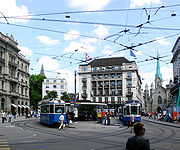
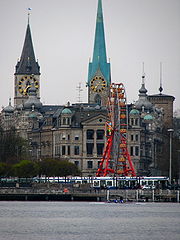
(lines 2, 4, 8, 9, 11 and buses 161, 165), situated at the southern end of the Bahnhofstrasse, and west of the Bellevue square, with which it is connected by the Quaibrücke. The lakeshore quay connecting the square with Lake Zurich
is named General-Guisan-Quai, after Henri Guisan
. From the quay, Zürichsee-Schifffahrtsgesellschaft
boat services leave for Thalwil
, Rapperswil
, Schmerikon
, Erlenbach
and down the Limmat
to Zürich Landesmuseum.
Bürkliplatz is named for Arnold Bürkli (1833–1894), the engineer responsible for the construction of the city's quays.
. Together with the Gessnerallee, Selnaustrasse and Sihlhölzlistrasse running along the right bank of the Sihl, it is part of the City quarter even though strictly situated without the city ramparts. Today, Zürich Selnau railway station
is a stop on the line of the Uetlibergbahn, running from Zürich Hauptbahnhof to the Sihltal (S4
) and to the Uetliberg
(S10
). The SWX Swiss Exchange
building is located in Selnau. The museum Haus Konstruktiv
is located in a former power station near Selnau train station.
Switzerland
Switzerland name of one of the Swiss cantons. ; ; ; or ), in its full name the Swiss Confederation , is a federal republic consisting of 26 cantons, with Bern as the seat of the federal authorities. The country is situated in Western Europe,Or Central Europe depending on the definition....
city of Zürich
Zürich
Zurich is the largest city in Switzerland and the capital of the canton of Zurich. It is located in central Switzerland at the northwestern tip of Lake Zurich...
encompasses the area of the entire historical city before 1893, before the incorporation of what are now districts 2 to 12 into the municipality, over the period 1893 to 1934. Altstadt approximately corresponds to the area enclosed by the former city ramparts
Fortifications of Zürich
Zurich was an independent city or city-state from 1218 to 1798. The town was fortified with a city wall from the 13th to the 17th century, and with more elaborate ramparts constructed in the 17th to 18th century and mostly demolished in the 1830s to 1870s.-First wall:There had been a first city...
, and is today within the administrative area of the city called Kreis 1 (District 1).
With a population of just below 5,600 (as of 2005), it houses about 1.5% of the city's total population.
Administratively, District 1 is divided into four parts or quarters by the Zürich
Zürich
Zurich is the largest city in Switzerland and the capital of the canton of Zurich. It is located in central Switzerland at the northwestern tip of Lake Zurich...
statistical office, Rathaus, Hochschulen, Lindenhof and City. Lindenhof and Rathaus correspond to the parts of the medieval city left (west) and right (east) of the Limmat
Limmat
The Limmat is a river in Switzerland. It is the continuation of the Linth river, known as Limmat from the point of effluence from Lake Zurich, in the city of Zurich. From Zurich it flows in a northwesterly direction, after 35 km reaching the river Aare...
, respectively, while City and Hochschulen include the area of the Early Modern city west and east of the medieval walls, respectively.

Lindenhof

La Tène culture
The La Tène culture was a European Iron Age culture named after the archaeological site of La Tène on the north side of Lake Neuchâtel in Switzerland, where a rich cache of artifacts was discovered by Hansli Kopp in 1857....
) times, and fortified as a Roman oppidum
Oppidum
Oppidum is a Latin word meaning the main settlement in any administrative area of ancient Rome. The word is derived from the earlier Latin ob-pedum, "enclosed space," possibly from the Proto-Indo-European *pedóm-, "occupied space" or "footprint."Julius Caesar described the larger Celtic Iron Age...
with a surrounding vicus
Vicus (Rome)
In ancient Rome, the vicus was a neighborhood. During the Republican era, the four regiones of the city of Rome were subdivided into vici. In the 1st century BC, Augustus reorganized the city for administrative purposes into 14 regions, comprising 265 vici. Each vicus had its own board of...
in the final decades of the 1st century BC.
The Lindenhof hill
Lindenhof hill
The Lindenhof hill is a moraine hill and a public square in the historic center of Zurich, Switzerland.- Topography :Lindenhof hill dominates Lindenhof quarter in the district 1 , the historical center of Zurich's Altstadt. To the North, it ends at Uraniastrasse and to the South near St. Peter...
itself is the site of the Roman castle, rebuilt in Carolingian
Carolingian
The Carolingian dynasty was a Frankish noble family with origins in the Arnulfing and Pippinid clans of the 7th century AD. The name "Carolingian", Medieval Latin karolingi, an altered form of an unattested Old High German *karling, kerling The Carolingian dynasty (known variously as the...
times but derelict by the 13th century, when it was used as a quarry for the first stone houses of rich burghers of the recently reichsfrei city. The Schipfe
Schipfe
Schipfe is part of the Lindenhof quarter in the district 1 of Zurich, Switzerland.It belongs to the historical parts of the Limmat city, located at the left side of the Limmat river below the Lindenhof hill. The Lindenhof was the site of the Roman settlement , with traces of a hypocaustum excavated...
quarter at the Limmat
Limmat
The Limmat is a river in Switzerland. It is the continuation of the Linth river, known as Limmat from the point of effluence from Lake Zurich, in the city of Zurich. From Zurich it flows in a northwesterly direction, after 35 km reaching the river Aare...
river below the Lindenhof is the site of the Roman vicus, with traces of a hypocaustum excavated. St. Peter church was the parish church of the medieval city, built on the site of an earlier temple to Jupiter.
The Rennweg
Rennweg (Zürich)
Rennweg is a street and a tram stop in the old town of Zurich.In the Middle Ages, it was the main street of the upper town of Zurich, leading from the fortified Rennweg gate passing below the Lindenhof hill towards the town hall....
street below the Lindenhof hill was the main street of the medieval city, entering by the Rennweg gate through the western city wall (now marked by the course of the Bahnhofstrasse. Augustinergasse
Augustinergasse (Zürich)
Augustinergasse is a street and a tram stop situated in the Lindenhof quarter of Zurich near Bahnhofstrasse and Rennweg.In the Middle Ages, it was a small street within the town of Zurich, leading from St. Peterhofstatt at the St. Peter church, passing the former Augustine monastery below the...
is a small street leading from St. Peterhofstatt situated at the St. Peter church, passing the former Augustinians
Augustinians
The term Augustinians, named after Saint Augustine of Hippo , applies to two separate and unrelated types of Catholic religious orders:...
monastery below the Lindenhof hill, towards the Kecinstürlin gate at the southern Fröschengraben moat, Bahnhofstrasse as of today. The quarter contains the Fraumünster
Fraumünster
The Fraumünster abbey in Zurich was founded in 853 by Louis the German for his daughter Hildegard. He endowed the Benedictine convent with the lands of Zurich, Uri, and the Albis forest, and granted the convent immunity, placing it under his direct authority.- History :In 1045, King Henry III...
, the abbey which ruled the town until the 1336 "guild revolution" of Rudolf Brun
Rudolf Brun
Rudolf Brun was the leader of the Zürich guilds' revolution of 1336, and the city's first independent mayor....
and which remained highly influential until Zwingli's Reformation. Zunfthaus zur Meisen
Zunfthaus zur Meisen
The Zunfthaus zur Meisen at Münsterhof is the guild house of the Zunft zur Meisen. It's one of the historically valuable buildings in the Lindenhof quarter in Zürich, Switzerland, and houses the porcelain and faience collection of the Swiss National Museum.- History :The guild house was built in...
at Münsterhof
Münsterhof (Zürich)
Münsterhof is a town square situated in the Lindenhof quarter, the historical center of Zürich, Switzerland.- Geography :Münsterhof is located in front of the Fraumünster church, to the south of the Lindenhof hill, and is surrounded by medieval buildings, among them the guild houses "zur Waag", the...
plaza near Fraumünster church houses the porcelain and faience collection of the Swiss National Museum
Swiss National Museum
The Swiss National Museum — part of the Musée Suisse Group, itself affiliated with the Federal Office of Culture — is one of the most important art museums of cultural history in Europe and the world...
. Lindenhof also contains the former Augustinian
Augustinians
The term Augustinians, named after Saint Augustine of Hippo , applies to two separate and unrelated types of Catholic religious orders:...
abbey, and formerly the Oetenbach abbey north of the Lindenhof hill, demolished in 1903 to make way for the Uraniastrasse as part the partially built «Urania-axis» Sihlporte–Uraniastrasse–Zähringerplatz by Gustav Gull, and the Urania Sternwarte
Urania Sternwarte
Urania Sternwarte is a public observatory in the Lindenhof quarter of Zurich, Switzerland. Its name Urania refers to the muse of astronomy in Greek mythology.- History :Its origins base on a first observatory on the roof of the Zunfthaus zur Meisen...
.
Rathaus




Zürich town hall
The Zurich town hall is the Rathaus of Zurich, Switzerland.- History :It was built in 1694-1698. It served as the seat of government of the Republic of Zurich until 1798...
, built in the 1690s.
It is the part of the medieval town on the right side of the Limmat, separated by the Hirschengraben from the Hochschulen quarter to the east, and delimited by the Bellevue and Central squares to the south and north, respectively. As such, it includes the Limmatquai as well as the Niederdorf
Niederdorf
-Places:Germany* Niederdorf, SaxonyItaly* Niederdorf, South Tyrol, a municipality in South TyrolSwitzerland* Niederdorf, Basel-Landschaft* Niederdorf, Zürich, a section of the old town in the City of Zürich...
(downstream of the Rathaus) and the Oberdorf (upstream of the Rathaus). The historical name of this eastern half of the medieval town was "greater town" (mehrere Stadt), contrasting with the "lesser town" (mindere Stadt), the western half along the left river bank.
Limmatquai
The Limmatquai was built along the right side of the Limmat, running from Central to Bellevue. It was built in the 19th century, connecting various earlier quais built into the Limmat. The current right bank is some 28 m west of the medieval river's. The quai was constructed from 1823–1859 from Bellevue to the Rathaus, in 1835–1836 from the Rathaus to the WasserkircheWasserkirche
The Wasserkirche of Zürich, first mentioned as ecclesia Aquatica Turicensi around 1250 and as wazzirkilcha in 1256, is a church built on a small island in the Limmat, situated between the two main churches of medieval Zürich, the Grossmünster and the Fraumünster.- Overview :The site was likely...
and 1835–1839 the portion from the Wasserkirche to Bellevue, formerly called Sonnenquai. At the Limmatquai are located some guild houses, as Zunfthaus zur Zimmerleuten, Zunfthaus zur Haue
Zunfthaus zur Haue
The Zunfthaus zur Haue at Limmatquai is the guildhall of the Zunft zum Kämbel, one of the 14 traditional guilds of Zürich. It is one of the historically notable buildings in the Rathaus quarter in Zürich, Switzerland.- History :...
, Zunfthaus zum Rüden
Zunfthaus zum Rüden
The Zunfthaus zum Rüden at Limmatquai is the guildhall of the Gesellschaft zur Constaffel, or guild of nobles, one of the 14 traditional guilds of Zürich. It is one of the historically notable buildings in the Rathaus quarter in Zürich, Switzerland.- History :The building was originally a modest...
and Zunfthaus zur Saffran.
Trams
Zürich trams
Trams make an important contribution to public transport in the city of Zurich in Switzerland. The tram network serves most city neighbourhoods, and is the backbone of public transport within the city, albeit supplemented by the inner sections of the Zurich S-Bahn, along with urban trolleybus and...
4 and 15 run along the Limmatquai, serving the stops Helmhaus, Rathaus and Rudolf-Brun-Brücke. The quai was one of the main routes through the old town before it was freed from traffic in 2004.
The bridges passed by the Limmatquai, south to north, are:
- Quaibrücke, connecting Bellevue and Bürkliplatz,
- Münsterbrücke between GrossmünsterGrossmünsterThe Grossmünster is a Romanesque-style church in Zurich, Switzerland. It is one of the three major churches in the city . The core of the present building near the banks of the Limmat River was constructed on the site of a Carolingian church, which was, according to legend, originally commissioned...
and FraumünsterFraumünsterThe Fraumünster abbey in Zurich was founded in 853 by Louis the German for his daughter Hildegard. He endowed the Benedictine convent with the lands of Zurich, Uri, and the Albis forest, and granted the convent immunity, placing it under his direct authority.- History :In 1045, King Henry III...
, - Rathausbrücke just north of the town hall,
- Rudolf-Brun-Brücke, between Mühlegasse and Uraniastrasse,
- the Mühlesteg footbridge
- Bahnhofbrücke, between Central and Zürich Hauptbahnhof.
north of Limmatquai:
- Walche-Brücke
- the Drahtschmidlisteg footbridge to Platzspitz
Niederdorf
The Niederdorf was the least developed part of the medieval city. It properly includes just the north-eastern corner, between Mühlegasse and Central, but the term was extended to the whole part of the mehrere Stadt north of the town hall, i.e. for the entire length of the Niederdorfstrasse, or even including the parts north of the Grossmünster.So defined, the Niederdorf includes Rindermarkt and Neumarkt, Froschaugasse and the area of the medieval Jewish quarter, the Predigerkirche (the former blackfriars' abbey) at Zähringerplatz (historically the city hospital, now housing the city library
Zentralbibliothek Zürich
Zentralbibliothek Zürich is the main library of both the city and the University of Zürich, housed in the Predigerkloster, the former Black Friars' abbey, in the old town's Rathaus quarter....
) and the Zähringerstrasse.
Münstergasse
The mehrere Stadt between the Niederdorf and the Oberdorf (between Rathaus and Grossmünster) includes the Münstergasse, Obere Zäune, Untere Zäune and the Barfüsserkloster (the former Franciscan abbey) as well as a number of alleys leaving Münstergasse: Marktgasse, Spiegelgasse, Krebsgasse, Ankengasse, Römergasse and Kirchgasse.Oberdorf
The Oberdorf proper is the mehrere Stadt south of the Grossmünster, along the Oberdorfstrasse, between Kirchgasse and Rämistrasse.Hochschulen



Fortifications of Zürich
Zurich was an independent city or city-state from 1218 to 1798. The town was fortified with a city wall from the 13th to the 17th century, and with more elaborate ramparts constructed in the 17th to 18th century and mostly demolished in the 1830s to 1870s.-First wall:There had been a first city...
(destroyed following the 1839 Züriputsch
Züriputsch
The Züriputsch of 6 September 1839 was a putsch of the rural conservative population against the liberal rule of the city of Zürich on the eve of the formation of the Swiss federal state. The reason for the putsch was the appointment of the controversial German theologian David Strauss to the...
), the hillside now holding the main buildings of both ETH Zurich
ETH Zurich
The Swiss Federal Institute of Technology Zurich or ETH Zürich is an engineering, science, technology, mathematics and management university in the City of Zurich, Switzerland....
(built 1861 to 1864 under Gustav Zeuner
Gustav Zeuner
Gustav Anton Zeuner was a German physicist, engineer and epistemologist, considered the founder of technical thermodynamics and of the Dresden School of Thermodynamics.-University and Revolution:...
) and University of Zurich
University of Zurich
The University of Zurich , located in the city of Zurich, is the largest university in Switzerland, with over 25,000 students. It was founded in 1833 from the existing colleges of theology, law, medicine and a new faculty of philosophy....
(built 1914 under Karl Moser
Karl Moser
Karl Moser was an architect from Switzerland.1887–1915 he worked together with Robert Curjel in Karlsruhe.Some of their works:* Kunsthaus Zurich* University of Zurich* Basel Badischer Bahnhof...
), at the sites of the Kronen Bollwerk and Schönenberg Bollwerk ramparts, respectively. Hochschulen borders on District 6
District 6 (Zürich)
District 6 is a district north of the old town in the Swiss city of Zurich.The district comprises the quarters Unterstrass and Oberstrass. Both entities were formerly municipalities of their own, but were incorporated into Zurich in 1893.-References:...
(Unterstrass
Unterstrass
Unterstrass is a quarter in the district 6 in Zurich.It was formerly a municipality of its own, having been incorporated into Zurich in 1893.The quarter has a population of 19,921 distributed on an area of 2.46 km².- References :...
and Oberstrass
Oberstrass
Oberstrass is a quarter in the district 6 in Zurich.It was formerly a municipality of its own, having been incorporated into Zurich in 1893.The quarter has a population of 9,494 distributed on an area of 2.64 km².-References:...
) to the north, on District 7
District 7 (Zürich)
District 7 is a district east of the old town in the Swiss city of Zurich.The district comprises the quarters Fluntern, Hottingen, Hirslanden and Witikon. All entities were formerly municipalities of their own, but were incorporated into Zurich in 1893 .-References:...
(Fluntern
Fluntern
Fluntern is a quarter in the district 7 in Zurich.It was formerly a municipality of its own, having been incorporated into Zurich in 1893.The quarter has a population of 7,325 distributed on an area of 2.84 km².-Weather:-References:...
and Hottingen
Hottingen
Hottingen may refer to:*Hottingen, Rickenbach, Baden-Württemberg, Germany*Hottingen , Canton of Zürich, SwitzerlandSee also Höttingen....
) to the east and on District 8 (Mühlebach
Mühlebach (Zürich)
Mühlebach is a quarter in the district 8 of Zurich.It was formerly a part of Riesbach municipality, which was incorporated into Zurich in 1893.The quarter has a population of 5,577 distributed on an area of 0.63 km².- References :...
) and Seefeld
Seefeld (Zürich)
Seefeld is a quarter in the district 8 of Zurich.It was formerly a part of Riesbach municipality, which was incorporated into Zurich in 1893. The quarter has a population of 4,923 distributed on an area of 2.45 km²; 71.6% of the district's area belongs to Lake Zurich.- Points of interest...
) to the south.
Hochschulen in its southern end also includes the Bellevue and Sechseläuten
Sechseläuten
The Sechseläuten is a traditional spring holiday in the Swiss city of Zürich celebrated in its current form since the early 20th century.-Burning of the Böögg:...
squares as well as the theater
Schauspielhaus Zürich
The Schauspielhaus Zürich is one of the most prominent and important theatres in the German-speaking world. It is also known as "Pfauenbühne" after its location on the Pfauen Square in Zürich, Switzerland. The large theatre has 750 seats...
and opera house
Zurich Opera House
Opernhaus Zürich is an opera house in the Swiss city of Zurich. It has been the home of the Zurich Opera since 1891.- History :...
and the Stadelhofen
Stadelhofen
Stadelhofen is a community in the Upper Franconian district of Bamberg and a member of the administrative community of Steinfeld.- Geography :...
train station. Tram stops
Zürich trams
Trams make an important contribution to public transport in the city of Zurich in Switzerland. The tram network serves most city neighbourhoods, and is the backbone of public transport within the city, albeit supplemented by the inner sections of the Zurich S-Bahn, along with urban trolleybus and...
in the Hochschulen quarter are: Central, ETH/Universitätsspital, Kantonsschule, Kunsthaus, Neumarkt, Bellevue, Opernhaus and Stadelhofen. Line 9 follows Rämistrasse which separates Hochschulen from Fluntern
Fluntern
Fluntern is a quarter in the district 7 in Zurich.It was formerly a municipality of its own, having been incorporated into Zurich in 1893.The quarter has a population of 7,325 distributed on an area of 2.84 km².-Weather:-References:...
, line 3 follows Hirschengraben and Seilergraben (the historical eastern moat), which separates it from the Rathaus quarter. The Polybahn
Polybahn
The Polybahn, also known as the UBS Polybahn, is a funicular railway in the centre of the city of Zurich, Switzerland. Previous names for the line include the SBG Polybahn and the Zürichbergbahn....
connects Central and the ETH Zurich
ETH Zurich
The Swiss Federal Institute of Technology Zurich or ETH Zürich is an engineering, science, technology, mathematics and management university in the City of Zurich, Switzerland....
main building.
Central
The Central square at the northern border between Rathaus and Hochschulen quarters is a major tramZürich trams
Trams make an important contribution to public transport in the city of Zurich in Switzerland. The tram network serves most city neighbourhoods, and is the backbone of public transport within the city, albeit supplemented by the inner sections of the Zurich S-Bahn, along with urban trolleybus and...
junction, served by lines 3, 4, 6, 7, 10 and 15 besides buses 31 and 46. Formerly called Leonhardsplatz, it was renamed after the Hotel Central built in 1883.
Pfauen
Situated at Pfauenplatz are the Schauspielhaus ZürichSchauspielhaus Zürich
The Schauspielhaus Zürich is one of the most prominent and important theatres in the German-speaking world. It is also known as "Pfauenbühne" after its location on the Pfauen Square in Zürich, Switzerland. The large theatre has 750 seats...
and the Kunsthaus Zürich
Kunsthaus Zürich
The Kunsthaus Zürich houses one of the most important art museums in Switzerland and Europe, collected by the local Kunstverein, called Zürcher Kunstgesellschaft, and holdings running from the Middle Ages to contemporary art, with an emphasis on Swiss art.Kunsthaus is also the name of the tram stop...
.
Bellevue
The Bellevue square at the southern border between Rathaus and Hochschulen quarters is a major tramZürich trams
Trams make an important contribution to public transport in the city of Zurich in Switzerland. The tram network serves most city neighbourhoods, and is the backbone of public transport within the city, albeit supplemented by the inner sections of the Zurich S-Bahn, along with urban trolleybus and...
junction, served by lines 2, 4, 5, 8, 9, 11 and 15 besides buses 912 and 916. It is situated at the lakeside, just north of Sechseläutenplatz. It is named for the Grandhotel Bellevue built in 1856.
Stadelhofen
South of Bellevue are the Sechseläutenplatz and Stadelhofenplatz squares. Stadelhofen was an estate just south of the southeastern-most bastion, the Stadelhofen Bollwerk, whilst Sechseläutenplatz takes its name from the SechseläutenSechseläuten
The Sechseläuten is a traditional spring holiday in the Swiss city of Zürich celebrated in its current form since the early 20th century.-Burning of the Böögg:...
, a traditional Zurich festival that is celebrated there.
Stadelhofen station, on Stadelhofenplatz, is an important stop of the Zürich S-Bahn
Zürich S-Bahn
The Zurich S-Bahn system is a network of rapid transit rail lines that has been incrementally expanded to cover the ZVV area, which comprises the entire canton of Zurich and portions of neighboring cantons The Zurich S-Bahn system is a network of rapid transit rail lines that has been...
lines to Uster
Uster
Uster is a city and capital of the district Uster in the Swiss Canton of Zürich.It is the third largest city in the Canton of Zürich, with over 30,000 inhabitants, and is one of the twenty largest cities in Switzerland...
, Rapperswil-Jona
Rapperswil-Jona
Rapperswil-Jona is a municipality in the Wahlkreis of See-Gaster in the canton of St. Gallen in Switzerland.Besides Rapperswil and Jona, which were separate municipalities until 2006, the municipality includes Bollingen, Busskirch, Curtiberg, Kempraten-Lenggis, Wagen, and Wurmsbach.-Today:On...
and Winterthur
Winterthur
Winterthur is a city in the canton of Zurich in northern Switzerland. It has the country's sixth largest population with an estimate of more than 100,000 people. In the local dialect and by its inhabitants, it is usually abbreviated to Winti...
as well as the terminal of the Forchbahn
Forchbahn
The Forchbahn is a gauge narrow-gauge light railway in the canton of Zürich, linking central Zürich to the eastern suburbs near Esslingen via Forch. The name is often abbreviated to just FB, which also appears on the trains...
(S18) line serving Zumikon
Zumikon
Zumikon is a municipality in the district of Meilen in the canton of Zürich in Switzerland. It is located in the Pfannenstiel region.-History:...
and Esslingen. The Zurich Opera House
Zurich Opera House
Opernhaus Zürich is an opera house in the Swiss city of Zurich. It has been the home of the Zurich Opera since 1891.- History :...
is also located in this area.
City
City is the area west of the Bahnhofstrasse, delimited by the SihlSihl
The Sihl is a river of Switzerland. It rises at Drusberg in the Canton of Schwyz. It passes through the Sihlsee near Einsiedeln, and then enters the Canton of Zurich, flowing through the Sihl valley at the foot of the Albis, passing the Sihlwald, the largest remaining deciduous forest of the Swiss...
and the Schanzengraben, the moat of the 17th century ramparts. It includes the Paradeplatz
Paradeplatz
The Paradeplatz is a square at the Bahnhofstrasse in downtown Zurich. The Paradeplatz tram stop is served by lines 2, 6, 7, 8, 9, 11 and 13...
, Zürich Hauptbahnhof, the Swiss National Museum
Swiss National Museum
The Swiss National Museum — part of the Musée Suisse Group, itself affiliated with the Federal Office of Culture — is one of the most important art museums of cultural history in Europe and the world...
and the Platzspitz park (formerly Limmatspitz). It comprises the tram stops Bürkliplatz, Paradeplatz, Rennweg, Bahnhofstrasse / Bahnhofplatz / Bahnhofquai, Löwenplatz, Sihlstrasse and Bahnhof Selnau. City borders on District 2
District 2 (Zürich)
District 2 is a district on the western side of Lake Zurich in the Swiss city of Zurich.The district comprises the quarters Wollishofen, Leimbach and Enge.-References:...
(Enge) to the southwest, and on Districts 4 and 5 (Aussersihl
Aussersihl
Aussersihl is a district in the Swiss city of Zurich. It is District number 4. The district is colloquially known as Chreis Cheib, cheib being the Zurich German word for an animal cadaver; the area historically contained pits for the deposition of dead animals.The district comprises the quarters...
) to the northwest.
Platzspitz

Limmat
The Limmat is a river in Switzerland. It is the continuation of the Linth river, known as Limmat from the point of effluence from Lake Zurich, in the city of Zurich. From Zurich it flows in a northwesterly direction, after 35 km reaching the river Aare...
and the Sihl
Sihl
The Sihl is a river of Switzerland. It rises at Drusberg in the Canton of Schwyz. It passes through the Sihlsee near Einsiedeln, and then enters the Canton of Zurich, flowing through the Sihl valley at the foot of the Albis, passing the Sihlwald, the largest remaining deciduous forest of the Swiss...
.
In medieval times, the area situated north of the city was used as pasture. In the early 15th century it was made into a shooting-range, and in the 16th to 17th centuries, Schützenfest
Schützenfest
A Schützenfest is a traditional festival or fair featuring a target shooting competition in the cultures of both Germany and Switzerland....
e were held there. A remnant of these can be found in the contemporary Knabenschiessen
Knabenschiessen
Knabenschiessen is a traditional target shooting competition in Zürich. held on the second weekend of September each year. The festival, officially held for the first time in 1889, is one of the oldest in Switzerland, dating back to the 17th century....
shooting contest.
During the 1990s, the long-practised official tolerance of drug users there from throughout Central Europe has been the subject of much worldwide media interest.
Hauptbahnhof

Bahnhofstrasse


Bürkliplatz
Bürkliplatz is a square and tram stopZürich trams
Trams make an important contribution to public transport in the city of Zurich in Switzerland. The tram network serves most city neighbourhoods, and is the backbone of public transport within the city, albeit supplemented by the inner sections of the Zurich S-Bahn, along with urban trolleybus and...
(lines 2, 4, 8, 9, 11 and buses 161, 165), situated at the southern end of the Bahnhofstrasse, and west of the Bellevue square, with which it is connected by the Quaibrücke. The lakeshore quay connecting the square with Lake Zurich
Lake Zurich
Lake Zurich is a lake in Switzerland, extending southeast of the city of Zurich. It is also known as Lake Zürich and Lake of Zürich. It lies approximately at co-ordinates ....
is named General-Guisan-Quai, after Henri Guisan
Henri Guisan
Henri Guisan was a Swiss army officer, and held the office of the General of the Swiss Army during World War II. He was the fourth and the most recent man to be appointed to the rarely used Swiss rank of General, and was possibly Switzerland's most famous soldier...
. From the quay, Zürichsee-Schifffahrtsgesellschaft
Zürichsee-Schifffahrtsgesellschaft
The Lake Zurich Shipping Company or Zürichsee-Schifffahrtsgesellschaft is a public Swiss company operating passenger ships and boats on Lake Zürich....
boat services leave for Thalwil
Thalwil
Thalwil is a municipality in the district of Horgen in the canton of Zürich in Switzerland. As of 2010 its population was of 17,189.-History:...
, Rapperswil
Rapperswil
Rapperswil-Jona is a municipality in the Wahlkreis of See-Gaster in the canton of St. Gallen in Switzerland.Besides Rapperswil and Jona, which were separate municipalities until 2006, the municipality includes Bollingen, Busskirch, Curtiberg, Kempraten-Lenggis, Wagen, and Wurmsbach.-Today:On...
, Schmerikon
Schmerikon
Schmerikon is a municipality in the Wahlkreis of See-Gaster in the canton of St. Gallen in Switzerland.-Geography:Schmerikon has an area, , of . Of this area, 38.9% is used for agricultural purposes, while 23% is forested...
, Erlenbach
Erlenbach
Erlenbach may refer to:*in Switzerland**Erlenbach, Switzerland, Canton of Zurich**Erlenbach im Simmental, Canton of Berne*in Germany**Erlenbach bei Marktheidenfeld, in the district Main-Spessart, Bavaria...
and down the Limmat
Limmat
The Limmat is a river in Switzerland. It is the continuation of the Linth river, known as Limmat from the point of effluence from Lake Zurich, in the city of Zurich. From Zurich it flows in a northwesterly direction, after 35 km reaching the river Aare...
to Zürich Landesmuseum.
Bürkliplatz is named for Arnold Bürkli (1833–1894), the engineer responsible for the construction of the city's quays.
Schanzengraben
On its remains at «zur Katz» ramparts, the Old Botanical Garden is located.Selnau
Selnau (from earlier Sellnau, Seldnau) was historically an estate west of the city, which came to lie between the north-western moat (Schanzengraben) and the SihlSihl
The Sihl is a river of Switzerland. It rises at Drusberg in the Canton of Schwyz. It passes through the Sihlsee near Einsiedeln, and then enters the Canton of Zurich, flowing through the Sihl valley at the foot of the Albis, passing the Sihlwald, the largest remaining deciduous forest of the Swiss...
. Together with the Gessnerallee, Selnaustrasse and Sihlhölzlistrasse running along the right bank of the Sihl, it is part of the City quarter even though strictly situated without the city ramparts. Today, Zürich Selnau railway station
Zürich Selnau railway station
Zürich Selnau, or Bahnhof Selnau, is a railway station on the Zürich S-Bahn system in Selnau in the centre of the Swiss city of Zürich...
is a stop on the line of the Uetlibergbahn, running from Zürich Hauptbahnhof to the Sihltal (S4
S4 (ZVV)
The S4 is a regional railway line of the Zurich S-Bahn on the Zürcher Verkehrsverbund , Zürich transportation network, in the canton of Zürich, Switzerland.- Route :The line runs from Zürich Hauptbahnhof to Langnau-Gattikon and Sihlwald...
) and to the Uetliberg
Uetliberg
The Üetliberg is a mountain in the Swiss plateau, part of the Albis chain, rising to 873 m . The Uetliberg offers a panoramic view of the entire city of Zurich and the Lake of Zurich. There is also a hotel in the name of "Uto Kulm" on this small mountain...
(S10
S10 (ZVV)
The S10 is a regional railway service in the Swiss canton of Zurich. It forms part of the Zurich S-Bahn on the Zürcher Verkehrsverbund , Zürich transportation network.- Route :...
). The SWX Swiss Exchange
SWX Swiss Exchange
SIX Swiss Exchange , based in Zurich, is Switzerland's principal stock exchange . SIX Swiss Exchange also trades other securities such as Swiss government bonds and derivatives such as stock options.The main stock market index for the SIX Swiss Exchange is the SMI, the Swiss Market Index...
building is located in Selnau. The museum Haus Konstruktiv
Haus Konstruktiv
Haus Konstruktiv, the Foundation for Constructive and Concrete Art, was founded by private individuals in 1986. From 1987 to spring 2001 it was located at Seefeldstrasse 317 in the outer Seefeld area of Zurich and was known as the "House for Constructive and Concrete Art".It is now situated in new...
is located in a former power station near Selnau train station.
See also
- History of ZurichHistory of ZürichZurich was continuously inhabited since Roman times. The name Zurich is possibly derived from the Celtic dur . It is first mentioned in 807 under the form Turigus, then in 853 as Turegus...
- Fortifications of ZurichFortifications of ZürichZurich was an independent city or city-state from 1218 to 1798. The town was fortified with a city wall from the 13th to the 17th century, and with more elaborate ramparts constructed in the 17th to 18th century and mostly demolished in the 1830s to 1870s.-First wall:There had been a first city...
External links
- http://www.altstadt-zuerich.ch/

